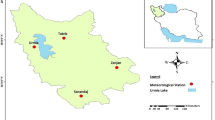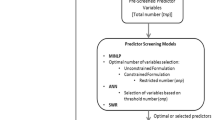Abstract
This study investigates the performance of the M5Tree model, multivariate adaptive regression spline, least square support vector regression (LSSVR), gene expressing programming (GEP) and artificial neural networks methods in estimating monthly long-term rainfall. Data from 61 rain stations in Madhya Pradesh and Chhattisgarh states, Central India, were used in the applications. Geographical inputs and periodicity were used as inputs to the models, and the methods were compared with each other according to the determination coefficient (R2), mean absolute errors (MAE) and root-mean-square errors (RMSE). LSSVR was found to be the best model with RMSE = 13.93 mm, MAE = 9.52 mm and R2 = 0.995 while the GEP provided the worst results with RMSE = 36.74 mm, MAE = 29.89 mm and R2 = 0.955 in prediction of long-term rainfall in the test stage. The lowest RMSE (5.53 mm) and MAE (3.89 mm) were obtained for the Rajnandgaon Station, while the Raigarh Station provided the worst accuracy (RMSE = 31.8 mm and MAE = 21.56 mm) for LSSVR model.




Similar content being viewed by others
References
Abraham A, Steinberg D, Philip NS (2001) Rainfall forecasting using soft computing models and multivariate adaptive regression splines. IEEE SMC Trans 1:1–6
Adamowski J, Chan HF, Prasher SO, Sharda VN (2012) Comparison of multivariate adaptive regression splines with coupled wavelet transform artificial neural networks for runoff forecasting in Himalayan micro-watersheds with limited data. J Hydroinform 14(3):731–744
Banzhaf W, Nordin P, Keller R, Francone F (1998) Genetic programming: an introduction: on the automatic evolution of computer programs and its applications. Co published by Morgan Kaufmann and Verlag, vol 340, 94104-3205
Bhagwat PP, Maity R (2012) Multistep-ahead river flow prediction using LS-SVR at daily scale. J Water Resour Protect 4(7):528–539
Bhattacharya B, Solomatine DP (2005) Neural networks and M5 model trees in modelling water level–discharge relationship. Neurocomputing 63:381–396
Bilgili M, Sahin M (2010) Prediction of long-term monthly temperature and rainfall in Turkey. Energy Sources Part A 32:60–71
De Andrés J, Lorca P, de Cos Juez FJ, Sánchez-Lasheras F (2011) Bankruptcy forecasting: a hybrid approach using fuzzy c-means clustering and multivariate adaptive regression splines (MARS). Expert Syst Appl 38(3):1866–1875
Deo RC, Kisi O, Singh VP (2017) Drought forecasting in eastern Australia using multivariate adaptive regression spline, least square support vector machine and M5Tree model. Atmos Res 184:149–175
Etemad-Shahidi A, Mahjoobi J (2009) Comparison between M5′ model tree and neural networks for prediction of significant wave height in Lake Superior. Ocean Eng 36(15):1175–1181
Ferreira C (2006) Gene expression programming: mathematical modeling by an artificial intelligence, vol 21. Springer, Berlin
Friedman JH (1991) Multivariate adaptive regression splines (with discussion). Ann Stat 19(1):79–141
Friedman JH (1991b) Estimating functions of mixed ordinal and categorical variables using adaptive splines. Stanford Univ CA Lab for Computational Statistics
Gajbhiye S, Meshram C, Mirabbasi R, Sharma SK (2016) Trend analysis of rainfall time series for Sindh River basin in India. Theor Appl Climatol 125:593–608
Gocić M, Motamedi S, Shamshirband S, Petković D, Ch S, Hashim R, Arif M (2015) Soft computing approaches for forecasting reference evapotranspiration. Comput Electron Agric 113:164–173
Gong Y, Zhang Y, Lan S, Wang H (2016) A comparative study of artificial neural networks, support vector machines and adaptive neuro fuzzy inference system for forecasting groundwater levels near Lake Okeechobee, Florida. Water Resour Manag 30(1):375–391
Han D, Chan L, Zhu N (2007) Flood forecasting using support vector machines. J Hydroinform 9(4):267–276
Hashim R, Roy C, Motamedi S, Shamshirband S, Petković D, Gocic M, Lee SC (2016) Selection of meteorological parameters affecting rainfall estimation using neuro-fuzzy computing methodology. Atmos Res 171:21–30
Haykin S (1998) Neural networks—a comprehensive foundation, 2nd edn. Prentice-Hall, Upper Saddle River
Khalili K, Nazeri Tahoudi M, Mirabbasi R, Ahmadi F (2016) Investigation of spatial and temporal variability of precipitation in Iran over the last half century. Stoch Environ Res Risk Assess 30(4):1205–1221
Kisi O (2015) Streamflow forecasting and estimation using least square support vector regression and adaptive neuro-fuzzy embedded fuzzy c-means clustering. Water Resour Manag 29(14):5109–5127
Kisi O, Sanikhani H (2015) Modelling long-term monthly temperatures by several data-driven methods using geographical inputs. Int J Climatol 35(13):3834–3846
Kisi O, Sanikhani H (2015) Prediction of long-term monthly precipitation using several soft computing methods without climatic data. Int J Climatol 35(14):4139–4150
Kisi O, Shiri J, Tombul M (2013) Modeling rainfall–runoff process using soft computing techniques. Comput Geosci 51:108–117
Kisi O, Sanikhani H, Zounemat-Kermani M, Niazi F (2015) Long-term monthly evapotranspiration modeling by several data-driven methods without climatic data. Comput Electron Agric 115:66–77
Legates DR, McCabe GJ (1999) Evaluating the use of “goodness-of-fit” measures in hydrologic and hydroclimatic model validation. Water Resour Res 35:233–241
Mirabbasi R (2015) Application of artificial intelligence methods for groundwater quality prediction. In: Nadiri AA (ed) Application of artificial intelligence methods in geosciences and hydrology. OMICS Group eBooks, Foster City. ISBN 978-1-63278-061-4-04
Moghaddamnia A, Ghafari M, Piri J, Han D (2009) Evaporation estimation using support vector machines technique. Int J Eng Appl Sci 5(7):415–423
Mukherjee S, Vapnik V (1999) Support vector method for multivariate density estimation. In: Center for biological and computational learning. Department of Brain and Cognitive Sciences, MIT. C.B.C.L. no. 170
Nash J, Sutcliffe J (1970) River flow forecasting through conceptual models part I—a discussion of principles. J Hydrol 10:282–290
Nourani V, Baghanam AH, Adamowski J, Kisi O (2014) Applications of hybrid wavelet–artificial intelligence models in hydrology: a review. J Hydrol 514:358–377
Özmen A, Batmaz İ, Weber GW (2014) Precipitation modeling by polyhedral RCMARS and comparison with MARS and CMARS. Environ Model Assess 19(5):425–435
Pal M, Deswal S (2009) M5 model tree based modelling of reference evapotranspiration. Hydrol Process 23(10):1437
Quinlan JR (1992) Learning with continuous classes. In: Proceedings of the fifth Australian joint conference on artificial intelligence, Hobart, Australia, 16–18 November. World Scientific, Singapore, pp 343–348
Raghavendra NS, Deka PC (2014) Support vector machine applications in the field of hydrology: a review. Appl Soft Comput 19:372–386
Saghebian SM, Sattari MT, Mirabbasi R, Pal M (2014) Ground water quality classification by decision tree method in Ardebil region, Iran. Arab J Geosci 7(11):4767–4777
Sahraei S, Andalani SZ, Zakermoshfegh M, Sisakht BN, Talebbeydokhti N, Moradkhani H (2015) Daily discharge forecasting using least square support vector regression and regression tree. Sci Iran Trans Civ Eng 22(2):410–422
Samui P (2011) Application of least square support vector machine (LSSVM) for determination of evaporation losses in reservoirs. Engineering 3(04):431
Sattari MT, Pal M, Apaydin H, Ozturk F (2013) M5 model tree application in daily river flow forecasting in Sohu stream, Turkey. Water Resour 40(3):233–242
Sattari MT, Pal M, Mirabbasi R, Abraham J (2018) Ensemble of M5 model tree based modelling of sodium adsorption ratio. J AI Data Min 6(1):69–78
Saunders C, Stitson MO, Weston J, Bottou L, Schölkopf B, Smola A (1998) Support vector machine—reference manual. Royal Holloway technical report CSD-TR-98-03. Royal Holloway
Shabri A, Suhartono (2012) Streamflow forecasting using least-squares support vector machines. Hydrol Sci J 57(7):1275–1293
Shamshirband S, Gocic M, Petkovic D, Saboohi H, Herawan T, Mat Kiah ML, Akib S (2015) Soft-computing methodologies for precipitation estimation: a case study. IEEE J Sel Top Appl Earth Observ Remote Sens 8(3):1353–1358
Sharda VN, Prasher SO, Patel RM, Ojasvi PR, Prakash C (2008) Performance of multivariate adaptive regression splines (MARS) in predicting runoff in mid-Himalayan micro-watersheds with limited data. Hydrol Sci J 53(6):1165–1175
Shenify M, Danesh AS, Gocić M, Taher RS, Abdul Wahab AW, Gani A, Shamshirband S, Petković D (2016) Precipitation estimation using support vector machine with discrete wavelet transform. Water Resour Manag 30(2):641–652
Shiri J, Marti P, Singh VP (2014) Evaluation of gene expression programming approaches for estimating daily evaporation through spatial and temporal data scanning. Hydrol Process 28(3):1215–1225
Singh KK, Pal M, Singh VP (2010) Estimation of mean annual flood in Indian catchments using backpropagation neural network and M5 model tree. Water Resour Manag 24(10):2007–2019
Smola AJ (1996) Regression estimation with support vector learning machines (Doctoral dissertation, Master’s thesis, Technische Universität München)
Sotomayor KAL (2010) Comparison of adaptive methods using multivariate regression splines (MARS) and artificial neural networks backpropagation (ANNB) for the forecast of rain and temperatures in the Mantaro river basin. Hydrology Days, pp 58–68
Sumi SM, Zaman M, Hirose H (2012) A rainfall forecasting method using machine learning models and its application to the Fukuoka city case. Int J Appl Math Comput Sci 22(4):841–854
Suykens J, De Brabanter J, De Moor B, Vandewalle JAK, Van Gestel T (2002) Least squares support vector machines, vol 4. World Scientific, Singapore
Swamee PK, Ojha CSP, Abbas A (1995) Mean annual flood estimation. J Water Resour Plan Manag 121(6):403–407
Teimoorzadeh K, Shiri J, Shiri AA (2015) Forecasting daily precipitation values, using wavelet conjunction models (case study: Tabriz and Marageh Stations, Iran). Science 34(4):265–269
Vapnik V (1995) The nature of statistical learning theory. Springer, New York
Wang Y, Min J, Chen Y, Huang XY, Zeng M, Li X (2017) Improving precipitation forecast with hybrid 3DVar and time-lagged ensembles in a heavy rainfall event. Atmos Res 183:1–16
Willmott CJ (1981) On the validation of models. Phys Geogr 2:184–194
Willmott CJ (1984) On the evaluation of model performance in physical geography. Spatial statistics and models. Springer, Berlin, pp 443–460
Zounemat-Kermani M, Kisi O, Rajaee T (2013) Performance of radial basis and LM-feed forward artificial neural networks for predicting daily watershed runoff. Appl Soft Comput 13(12):4633–4644
Author information
Authors and Affiliations
Corresponding author
Rights and permissions
About this article
Cite this article
Mirabbasi, R., Kisi, O., Sanikhani, H. et al. Monthly long-term rainfall estimation in Central India using M5Tree, MARS, LSSVR, ANN and GEP models. Neural Comput & Applic 31, 6843–6862 (2019). https://doi.org/10.1007/s00521-018-3519-9
Received:
Accepted:
Published:
Issue Date:
DOI: https://doi.org/10.1007/s00521-018-3519-9




